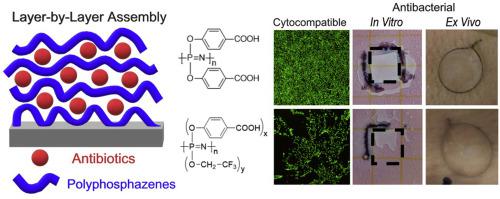Biomaterials ( IF 12.8 ) Pub Date : 2020-12-01 , DOI: 10.1016/j.biomaterials.2020.120586 Victoria Albright 1 , Daniel Penarete-Acosta 2 , Mary Stack 3 , Jeremy Zheng 2 , Alexander Marin 4 , Hanna Hlushko 1 , Hongjun Wang 5 , Arul Jayaraman 6 , Alexander K Andrianov 4 , Svetlana A Sukhishvili 1

|
Biocompatible antibacterial coatings are highly desirable to prevent bacterial colonization on a wide range of medical devices from hip implants to skin grafts. Traditional polyelectrolytes are unable to directly form coatings with cationic antibiotics at neutral pH and suffer from high degrees of antibiotic release upon exposure to physiological concentrations of salt. Here, novel inorganic-organic hybrid polymer coatings based on direct layer-by-layer assembly of anionic polyphosphazenes (PPzs) of various degrees of fluorination with cationic antibiotics (polymyxin B, colistin, gentamicin, and neomycin) are reported. The coatings displayed low levels of antibiotic release upon exposure to salt and pH-triggered response of controlled doses of antibiotics. Importantly, coatings remained highly surface active against Escherichia coli and Staphylococcus aureus, even after 30 days of pre-exposure to physiological conditions (bacteria-free) or after repeated bacterial challenge. Moreover, coatings displayed low (<1%) hemolytic activity for both rabbit and porcine blood. Coatings deposited on either hard (Si wafers) or soft (electrospun fiber matrices) materials were non-toxic towards fibroblasts (NIH/3T3) and displayed controllable fibroblast adhesion via PPz fluorination degree. Finally, coatings showed excellent antibacterial activity in ex vivo pig skin studies. Taken together, these results suggest a new avenue to form highly tunable, biocompatible polymer coatings for medical device surfaces.
中文翻译:

聚磷腈可实现耐用、血液相容、高效的抗菌涂层
生物相容性抗菌涂层非常适合防止细菌在从髋关节植入物到皮肤移植的各种医疗器械上定植。传统的聚电解质无法在中性 pH 值下直接与阳离子抗生素形成涂层,并且在暴露于生理浓度的盐时会出现高度的抗生素释放。在这里,报道了基于不同氟化度的阴离子聚磷腈 (PPz) 与阳离子抗生素(多粘菌素 B、粘菌素、庆大霉素和新霉素)直接逐层组装的新型无机-有机杂化聚合物涂层。涂层在暴露于盐和控制剂量抗生素的 pH 值触发反应时显示出低水平的抗生素释放。重要的是,涂层保持高度的表面活性大肠杆菌和金黄色葡萄球菌,即使在预先暴露于生理条件(无细菌)30 天后或在重复细菌攻击后也是如此。此外,涂层对兔血和猪血都显示出低(<1%)的溶血活性。沉积在硬(Si 晶片)或软(电纺纤维基质)材料上的涂层对成纤维细胞 (NIH/3T3) 无毒,并且通过PPz 氟化度显示出可控的成纤维细胞粘附。最后,涂层在离体猪皮肤研究中显示出优异的抗菌活性。综上所述,这些结果表明了一种为医疗器械表面形成高度可调、生物相容性聚合物涂层的新途径。











































 京公网安备 11010802027423号
京公网安备 11010802027423号